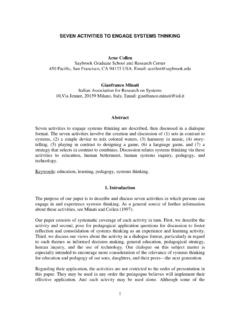Transcription of 10 - Learning – games
1 P1: 521 83643 3 September4,200513:1110 Semiotic Social Spaces and Affinity SpacesFromThe Age of Mythologyto Today s SchoolsJames Paul Geeintroduction: from groups to spacesIn this paper, I consider an alternative to the notion of a communityof practice (Lave and Wenger1991;Wenger1998). This alternativefocuses on the idea of aspacein which people interact, rather thanonmembershipin a community. I want to consider this alternativebecause I believe that the notion of what I will later call an affinityspace is a particularly important contemporary social configurationwith implications for the future of schools and notion of a community of practice has been a fruitful , it has given rise to several problems, some of which are: The idea of community can carry connotations of belonging-ness and close-knit personal ties among people which do notnecessarily always fit classrooms, workplaces or other sites wherethe notion of a community of practice has been used.
2 The idea of community seems to bring with it the notion of peo-ple being members . However, membership means such dif-ferent things across different sorts of communities of practice, andthere are so many different ways and degrees of being a member insome communities of practice that it is not clear that membershipis a truly helpful notion. While Wenger (see Wenger, McDermott and Snyder2002) has triedto be careful in delineating just what is and what is not a commu-nity of practice, distinguishing it from other sorts of affiliations,214P1: 521 83643 3 September4,200513:11 Semiotic Social Spaces and Affinity Spaces215the notion has been used by others to cover such a wide array ofsocial forms that we may be missing the trees for the my view, the key problem with notions like community of prac-tice , and related ones like communities of learners , is that theymake it look like we are attempting to label a group of people.
3 Oncethis is done, we face vexatious issues over which people are in andwhich are out of the group, how far they are in or out and when theyare in or out. The answers to these questions vary even their veryanswerability varies greatly across different social groupings. If westart with the notion of a community we cannot go any furtheruntil we have defined who is in and who is not, since otherwise wecannot identify the community. Yet it is often issues of participation,membership and boundaries that are problematic in the first for example my own discipline of linguistics and try to con-strue it as a community of practice. Should we separate out appliedlinguistics, sociolinguistics, historical linguistics, theoretical linguis-tics and so forth as separate communities of practice?
4 How long is thelist? Or can we just treat linguistics as one big category? Is a personwith a degree outside linguistics working on linguistic problems alinguist or not? Is a person with a in linguistics working on is-sues tangential to linguistics a linguist? Which of the many practiceswhich linguists engage should we select to begin answering suchquestions? Is the matter of who is a linguist settled by negotiationswithin moment-to-moment social interactions, by larger institutionalrealities or by the opinions of certain insiders ?Or take a high-school science class. Johnny and Janie are both inthe class. Janie is proactively attempting to engage with the science inthe class, but Johnny is playing the game for a passing grade.
5 Arethey in the same community of practice or is Janie in a school-sciencecommunity of practice and Johnny in a doing school community ofpractice. What sense does it make to say all the students in this classare in some (one?) community of practice just because they are allcontained by the same four walls? Or if we think beyond those fourwalls, if some parents are helping their children in science, are they inthe community of practice, too? What about the principal, the otherscience teachers, the reading specialist who comes into the class oncea week, the author of the textbook or for that matter the curriculumP1: 521 83643 3 September4,200513:11216 Beyond Communities of Practicespecialists and policy-makers who help shape the classroom s prac-tices in regard to science and schooling more generally?
6 I suggest that the problem here is trying to start with a label (likecommunity of practice) which looks like a label for a group of people,agroup which must then be identified in terms of its members .What I want to suggest, instead, is that (at least, sometimes) we startwith spaces and not groups. The spaces I want to start with arewhat I will call semiotic social spaces (I will use SSS singular, SSSs plural for short) because what I am concerned with aboutthese spaces is the way in which people get and give meanings tosigns within I say what a SSS is, let me start with an analogy. It is hardto say who is and who is not an American.
7 (I mean by this notwho is officially a citizen or not, but who is in American culture ,whatever that may mean. There are people who are not citizens whoimpress me as very American and there are citizens who impressme as not very American .) For some purposes, it may be easier todraw the boundaries of the United States as a geographical space ona map and then look at how different sorts of people use that space , what they do there and what they get from that space ( , importor export from it).Of course, I do not want to talk just about physical or geographicalspaces. Just as people can enter a physical space like the United States,they can enter a virtual space like a website or a chat room.
8 Peopleinteracting with each other about a specific disease on a patient em-powerment website are in a virtual space together. There are spacesthat are mixtures of the real and the virtual, such as a meeting in whichsome people are physically together in a room and others are inter-acting with the group via the Internet or over a video-conferencingsystem. People who play chess with each other by sending movesvia email or letters are interacting, at a distance, in a space created byemail or the postal service. Modern technologies allow the creationof more and more spaces where people can enter and interact withothers (and with objects and tools) at a distance.
9 So when I talk about spaces I don t mean just physical goal, however, is not just or primarily to introduce the idea ofSSSs. Rather, it is to discuss a particular type of SSS that I will call an affinity space . I will first define what I mean by SSSs generally andP1: 521 83643 3 September4,200513:11 Semiotic Social Spaces and Affinity Spaces217then define what I mean by an affinity space in particular. When I getto affinity spaces, I will argue that they capture one characteristicallymodern and important form of social affiliation, one that can fruit-fully be compared and contrasted with other forms (Gee2000 2001).I will define what I mean by a SSS through one concrete example, anexample that also happens to be an affinity space.
10 This will allow meto characterise what makes this example a SSS and then turn to whatmakes it an affinity social spaces: aomTodefine what I mean by a SSS, I will use as my illustrative ex-ample the SSS of real-time strategy computer games , using thegameAge of Mythology( AoM for short) as a paradigmatic in-stance of such a game ( ). In a real-time strategy game, theplayer builds buildings, settlements, towns and/or cities for a given civilisation , using workers to collect gold, farm land, cut wood andhunt animals to gain the necessary resources for building and sus-taining his or her civilisation.







